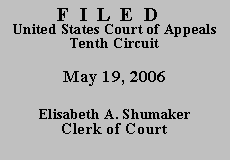

UNITED STATES OF AMERICA,
Plaintiff-Appellee,
v.
GILBERT TODD ELLIS,
Defendant-Appellant.
Before KELLY, McKAY, and
LUCERO, Circuit Judges.
After examining the briefs and appellate record, this panel has determined unanimously to honor the parties' request for a decision on the briefs without oral argument. See Fed. R. App. P. 34(f). The case is therefore submitted without oral argument.
Appellant was charged with one count of possession of ammunition by a convicted felon, in violation of 18 U.S.C. § 922(g)(1). He filed a motion to suppress the ammunition evidence. The district court held a hearing on the motion and denied it. Appellant then entered a conditional plea of guilty that preserved his right to appeal the district court's ruling on his motion to suppress. Appellant was sentenced to thirty-seven months' imprisonment. He appeals the district court's suppression ruling, contesting that there was no reasonable suspicion to support his detention or his subjection to a Terry frisk.
When reviewing the denial of a motion to suppress based on an allegation that officers violated a defendant's Fourth Amendment rights, we consider the totality of the circumstances and view the evidence in the light most favorable to the government, accepting the district court's findings of facts unless they are clearly erroneous. United States v. Gay, 240 F.3d 1222, 1225-26 (10th Cir. 2001). "However, the ultimate determination of the reasonableness under the Fourth Amendment is reviewed de novo." United States v. Lang, 81 F.3d 955, 964 (10th Cir. 1996).
On August 24, 2004, officers were conducting surveillance near a neighborhood convenience store, having received numerous anonymous complaints through a drug tip hotline about individuals possibly buying and selling drugs in the area. The officers observed a car pull into the convenience store parking lot, but no one exited the vehicle. An individual then approached the car, leaned through the window to converse with the occupants, and left. This scenario was repeated. Appellant and the convenience store owner then approached the car; the owner told the car's occupants that they could not park there, and Appellant, who evidently recognized the driver, asked for a ride.
At this time the police officers approached the parked vehicle and ordered the three occupants to show their hands. The driver and front seat passenger complied, but the back seat passenger did not. As the back seat passenger reached down below his leg, the officer drew his own weapon and ordered Appellant and the convenience store owner (who were still standing near the vehicle) to get down on the ground.
Another officer arrived on the scene and, having recognized Appellant from a prior drug arrest, focused his attention on him. Appellant attempted to rise up from the ground and repeatedly stated that he had done nothing wrong. The officer conducted a frisk of both Appellant and the store owner. While searching Appellant, the officer felt something hard in his pant pocket, which he believed was a magazine for a gun. The officer then handcuffed Appellant, checked the pant's pocket, and seized the gun magazine.
Appellant argues that the district court erred in denying his suppression motion because he contends that the officers had no reasonable suspicion to detain him. The record reflects: (1) there were numerous citizen-informant complaints regarding hand-to-hand drug transactions in a specified area; (2) Appellant was observed approaching a suspicious car and talking to an occupant immediately after two individuals had separately approached the same car engaged in conduct consistent with a hand-to-hand drug transaction; and (3) one of the officers knew that Appellant had a criminal record, including an arrest for drug possession.
A brief detention is permissible if based on "reasonable suspicion to believe that criminal activity may be afoot." United States v. Quintana-Garcia, 343 F.3d 1266, 1270 (10th Cir. 2003) (internal quotations omitted). The record in this case supports this belief.
Appellant also argues that the officers had no reasonable suspicion to justify a frisk for weapons. During the course of an investigative detention, "an officer may conduct a pat-down search (or 'frisk') if he or she 'harbors an articulable and reasonable suspicion that the person is armed and dangerous.'" United States v. Hishaw, 235 F.3d 565, 570 (10th Cir. 2000) (quoting United States v. Davis, 94 F.3d 1465, 1468 (10th Cir. 1996)). In this case, the officer's suspicion that Appellant was involved in drug activity, coupled with his non-compliance with the officers' commands to lie on the ground, supported a reasonable suspicion that he was armed and dangerous. Reasonable suspicion that an individual is involved in drug dealing, standing alone, may justify a frisk for weapons because "[t]he crimes about which [the officer] was concerned are typically associated with some sort of weapon . . . ." United States v. Johnson, 364 F.3d 1185, 1195 (10th Cir. 2005); see also Hishaw, 235 F.3d at 570-71. Given the totality of the circumstances, especially in light of Appellant's non-compliance in a charged situation, we determine that the officers had reasonable suspicion to conduct a frisk for weapons.
We have carefully reviewed the briefs of Appellant and Appellee, the district court's disposition, and the record on appeal. We are in accord with the district court's denial of Appellant's suppression motion, and we consequently AFFIRM the district court's June 30, 2005, sentence.
Entered for the Court
Monroe G. McKay
Circuit Judge
*. This order and judgment is not binding precedent, except under the doctrines of law of the case, res judicata, and collateral estoppel. The court generally disfavors the citation of orders and judgments; nevertheless, an order and judgment may be cited under the terms and conditions of 10th Cir. R. 36.3.